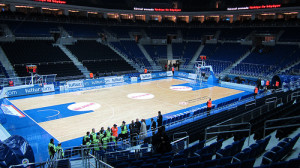When Should You Use a Full Court Trap?
A Full Court Trap can be one of the most effective tactics within a team’s playbook if used wisely. Very few full court traps are effective over an extended period of time, because an opposition learns to adapt and probe weakness until they finally become consistent and confident enough to overcome the challenge. For this reason, understanding the best times to use a full court trap is important to be able to get the most out of the tactic.
Poor Ball Handlers on the Court
All teams have strong and weak ball handlers. Sometimes teams will have a weaker dribbling player from the very start depending on the players’ abilities they have in their team. Understanding which players do not have solid ball handling skills should really come from scouting the opposition prior to the game. However, if this is not possible then probing each player to see how they deal with the pressure can be effective in revealing who will struggle or not by using a full court trap in a rotation of tactics.
Once a coach understands who are to the be the targets, then a full court trap can be implemented to help bring pressure upon this player or players once they are on the floor.
As an added bonus this might also have the added benefit of opposition players (such as the better ball handler) not being able to be rested as frequently as needed, which in turn can wear a player down over the course of a game.

End of a Quarter
Another useful time to explore using a full court trap is when the opposition is most likely rotating a large number of the second string players onto the floor. Times such as towards the end of a quarter are these periods when back-up players start to hit the court in great numbers to give starters a rest. This can be a useful time to implement a full court trap, as these players will often not be as confident in their ability or as experienced in making the right read often.
Following a Time-Out
A common move by coaches when they find their team is struggling against a full court trap is to call a time-out to stop play and give the coach the time needed to refocus players on the task at hand. This strategy can be voided if a defensive minded coach waits for the opposition to use a time-out prior to implementing a full court trap.
This strategy can be even more effective if a coach has used their last time-out prior to halftime or the end of a game.
Dead Ball Situations
Any time the ball has to be inbounded in the backcourt is an opportunity to run a full court trap. Following a score is the most common, but others include:
- Following a foul shot
- Inbound from the baseline
- Inbound from the sideline; provided the distance is not too close to the halfway line and condenses the defence too much
Alternating Defensive Tactics
Another way to help with breaking up the use of a full court trap is to implement it in rotation with other defensive tactics. For example, a full court trap could be used when a team scores, while if the opposition rebounds or steals the ball the team may utilise a 2-3 Zone Defence. By rotating the type of defence being utilised the offense will need to constantly adjust and this in turn can take time and prove to be advantageous.
The full court trap is a useful tool, but needs to be used in the right situation for it to be effective and create opportunities. If it does not then the advantage is lost by the defence and an possession has been thrown away by the defence in which they can set the tone and tempo of a game.





